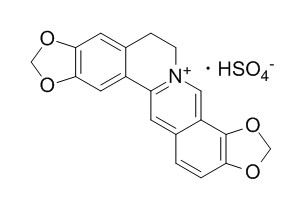Coptisine sulfate
Coptisine sulfate can competitively inhibit CYP2D6(*)1 and CYP2D6(*)10, its Ki values for CYP2D6(*)1 and CYP2D6(*)10 are very close, suggesting that genotype-dependent herb-drug inhibition is similar between the two variants.
Inquire / Order:
manager@chemfaces.com
Technical Inquiries:
service@chemfaces.com
Tel:
+86-27-84237783
Fax:
+86-27-84254680
Address:
1 Building, No. 83, CheCheng Rd., Wuhan Economic and Technological Development Zone, Wuhan, Hubei 430056, PRC
Providing storage is as stated on the product vial and the vial is kept tightly sealed, the product can be stored for up to
24 months(2-8C).
Wherever possible, you should prepare and use solutions on the same day. However, if you need to make up stock solutions in advance, we recommend that you store the solution as aliquots in tightly sealed vials at -20C. Generally, these will be useable for up to two weeks. Before use, and prior to opening the vial we recommend that you allow your product to equilibrate to room temperature for at least 1 hour.
Need more advice on solubility, usage and handling? Please email to: service@chemfaces.com
The packaging of the product may have turned upside down during transportation, resulting in the natural compounds adhering to the neck or cap of the vial. take the vial out of its packaging and gently shake to let the compounds fall to the bottom of the vial. for liquid products, centrifuge at 200-500 RPM to gather the liquid at the bottom of the vial. try to avoid loss or contamination during handling.
The Korea Journal of Herbology2016, 29-35
Phytomedicine.2021, 2(82):153452
Nutrients.2020, 12(12):3638.
Int J Mol Sci.2024, 25(5):2914.
Plants (Basel).2023, 12(11):2107.
J Med Food.2021, 24(2):151-160.
Neuropharmacology2019, 151437
Antioxidants (Basel).2020, 9(11):1121.
BMC Complement Altern Med.2014, 14:352
Biomed Pharmacother.2021, 144:112300.
Related and Featured Products
Acta Pharmacol Sin. 2014 May;35(5):685-96.
Inhibitory effects of phytochemicals on metabolic capabilities of CYP2D6(*)1 and CYP2D6(*)10 using cell-based models in vitro.[Pubmed:
24786236 ]
Herbal products have been widely used, and the safety of herb-drug interactions has aroused intensive concerns. This study aimed to investigate the effects of phytochemicals on the catalytic activities of human CYP2D6(*)1 and CYP2D6(*)10 in vitro.
METHODS AND RESULTS:
HepG2 cells were stably transfected with CYP2D6(*)1 and CYP2D6(*)10 expression vectors. The metabolic kinetics of the enzymes was studied using HPLC and fluorimetry. HepG2-CYP2D6(*)1 and HepG2-CYP2D6(*)10 cell lines were successfully constructed. Among the 63 phytochemicals screened, 6 compounds, including Coptisine sulfate, bilobalide, schizandrin B, luteolin, schizandrin A and puerarin, at 100 μmol/L inhibited CYP2D6(*)1- and CYP2D6(*)10-mediated O-demethylation of a coumarin compound AMMC by more than 50%. Furthermore, the inhibition by these compounds was dose-dependent. Eadie-Hofstee plots demonstrated that these compounds competitively inhibited CYP2D6(*)1 and CYP2D6(*)10. However, their Ki values for CYP2D6(*)1 and CYP2D6(*)10 were very close, suggesting that genotype-dependent herb-drug inhibition was similar between the two variants.
CONCLUSIONS:
Six phytochemicals inhibit CYP2D6(*)1 and CYP2D6(*)10-mediated catalytic activities in a dose-dependent manner in vitro. Thus herbal products containing these phytochemicals may inhibit the in vivo metabolism of co-administered drugs whose primary route of elimination is CYP2D6.



